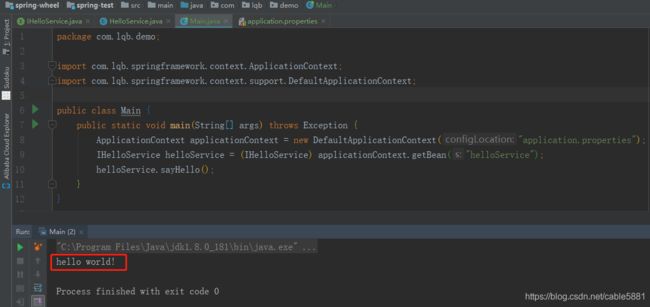手撸一个简易Spring框架(三)
目录
- 前言
- 非懒加载的提前初始化
- 初始化核心方法getBean
- 依赖注入
- 中段成果展示
- 最后
前言
上一章fresh()中还差第4步“Bean实例化”没有完成,这一章就来搞定它,大名鼎鼎的DI依赖注入也会在这Bean实例化的过程中完成。
非懒加载的提前初始化
这是fresh()的最后一步,逻辑是遍历BeanDefinition集合,将非懒加载的Bean提前初始化。
public void refresh() throws Exception {
//1、定位,定位配置文件
reader = new BeanDefinitionReader(this.configLocation);
//2、加载配置文件,扫描相关的类,把它们封装成BeanDefinition
List<BeanDefinition> beanDefinitions = reader.loadBeanDefinitions();
//3、注册,把配置信息放到容器里面(伪IOC容器)
//到这里为止,容器初始化完毕
doRegisterBeanDefinition(beanDefinitions);
//4、把不是延时加载的类,提前初始化
doAutowired();
}
private void doAutowired() {
for (Map.Entry<String, BeanDefinition> beanDefinitionEntry : beanDefinitionMap.entrySet()) {
String beanName = beanDefinitionEntry.getKey();
if (!beanDefinitionEntry.getValue().isLazyInit()) {
try {
getBean(beanName);
} catch (Exception e) {
e.printStackTrace();
}
}
}
}
可见实例化的核心方法就是getBean(),它是BeanFactory中的接口方法,我们在系列第二章已经将此框架搭出来了,下面来具体实现它。
初始化核心方法getBean
核心逻辑也不难:
- 如果已经实例化了,则直接获取实例化后的对象返回即可。如果没有实例化则走后面的逻辑
- 拿到该Bean的BeanDefinition 信息,通过反射实例化
- 将实例化后的对象封装到BeanWrapper中
- 将封装好的BeanWrapper保存到IOC容器(实际就是一个Map)中
- 依赖注入实例化的Bean
- 返回最终实例
/**保存了真正实例化的对象*/
private Map<String, BeanWrapper> factoryBeanInstanceCache = new ConcurrentHashMap<>();
@Override
public Object getBean(String beanName) throws Exception {
//如果是单例,那么在上一次调用getBean获取该bean时已经初始化过了,拿到不为空的实例直接返回即可
Object instance = getSingleton(beanName);
if (instance != null) {
return instance;
}
BeanDefinition beanDefinition = this.beanDefinitionMap.get(beanName);
//1.调用反射初始化Bean
instance = instantiateBean(beanName, beanDefinition);
//2.把这个对象封装到BeanWrapper中
BeanWrapper beanWrapper = new BeanWrapper(instance);
//3.把BeanWrapper保存到IOC容器中去
//注册一个类名(首字母小写,如helloService)
this.factoryBeanInstanceCache.put(beanName, beanWrapper);
//注册一个全类名(如com.lqb.HelloService)
this.factoryBeanInstanceCache.put(beanDefinition.getBeanClassName(), beanWrapper);
//4.注入
populateBean(beanName, new BeanDefinition(), beanWrapper);
return this.factoryBeanInstanceCache.get(beanName).getWrappedInstance();
}
private Object instantiateBean(String beanName, BeanDefinition beanDefinition) {
//1、拿到要实例化的对象的类名
String className = beanDefinition.getBeanClassName();
//2、反射实例化,得到一个对象
Object instance = null;
try {
Class<?> clazz = Class.forName(className);
instance = clazz.newInstance();
} catch (Exception e) {
e.printStackTrace();
}
return instance;
}
依赖注入
上一步中Bean只是实例化了,但是Bean中被@Autowired注解的变量还没有注入,如果这个时候去使用就会报空指针异常。下面是注入的逻辑:
- 拿到Bean中的所有成员变量开始遍历
- 过滤掉没有被@Autowired注解标注的变量
- 拿到被注解变量的类名,并从IOC容器中找到该类的实例(上一步已经初始化放在容器了)
- 将变量的实例通过反射赋值到变量中
private void populateBean(String beanName, BeanDefinition beanDefinition, BeanWrapper beanWrapper) {
Class<?> clazz = beanWrapper.getWrappedClass();
//获得所有的成员变量
Field[] fields = clazz.getDeclaredFields();
for (Field field : fields) {
//如果没有被Autowired注解的成员变量则直接跳过
if (!field.isAnnotationPresent(Autowired.class)) {
continue;
}
Autowired autowired = field.getAnnotation(Autowired.class);
//拿到需要注入的类名
String autowiredBeanName = autowired.value().trim();
if ("".equals(autowiredBeanName)) {
autowiredBeanName = field.getType().getName();
}
//强制访问该成员变量
field.setAccessible(true);
try {
if (this.factoryBeanInstanceCache.get(autowiredBeanName) == null) {
continue;
}
//将容器中的实例注入到成员变量中
field.set(beanWrapper.getWrappedInstance(), this.factoryBeanInstanceCache.get(autowiredBeanName).getWrappedInstance());
} catch (IllegalAccessException e) {
e.printStackTrace();
}
}
}
中段成果展示
上一章中我们完成了IOC容器的初始化,本章完成了Bean的初始化和依赖注入,按道理说是应该可以正常启动容器并可以通过getBean()来获取到被Spring管理的Bean了,下面来检验一下成果。
将我们的项目通过mvn clean install打成jar包,此时如果读者碰到打包失败不妨在项目的pom中添加一个打包插件。
<project xmlns="http://maven.apache.org/POM/4.0.0"
xmlns:xsi="http://www.w3.org/2001/XMLSchema-instance"
xsi:schemaLocation="http://maven.apache.org/POM/4.0.0 http://maven.apache.org/xsd/maven-4.0.0.xsd">
<modelVersion>4.0.0modelVersion>
<groupId>com.lqbgroupId>
<artifactId>my-springartifactId>
<version>1.0-SNAPSHOTversion>
<properties>
<servlet.api.version>2.4servlet.api.version>
properties>
<dependencies>
<dependency>
<groupId>org.projectlombokgroupId>
<artifactId>lombokartifactId>
<version>1.18.8version>
<scope>providedscope>
dependency>
dependencies>
<build>
<plugins>
<plugin>
<artifactId>maven-compiler-pluginartifactId>
<version>2.3.2version>
<configuration>
<source>1.8source>
<target>1.8target>
<encoding>UTF-8encoding>
<compilerArguments>
<verbose />
<bootclasspath>${java.home}/lib/rt.jarbootclasspath>
compilerArguments>
configuration>
plugin>
plugins>
build>
project>
新建一个空Maven项目,并引用我们的工程。
<project xmlns="http://maven.apache.org/POM/4.0.0"
xmlns:xsi="http://www.w3.org/2001/XMLSchema-instance"
xsi:schemaLocation="http://maven.apache.org/POM/4.0.0 http://maven.apache.org/xsd/maven-4.0.0.xsd">
<parent>
<artifactId>spring-wheelartifactId>
<groupId>com.lqbgroupId>
<version>1.0-SNAPSHOTversion>
parent>
<modelVersion>4.0.0modelVersion>
<artifactId>spring-testartifactId>
<dependencies>
<dependency>
<groupId>com.lqbgroupId>
<artifactId>my-springartifactId>
<version>1.0-SNAPSHOTversion>
dependency>
dependencies>
project>
在resource目录下新建配置文件application.properties并指定扫描路径
scanPackage=com.lqb.demo
在制定的扫描路径下定义一个接口IHelloService,以及HelloService实现这个接口
package com.lqb.demo;
public interface IHelloService {
void sayHello();
}
package com.lqb.demo;
import com.lqb.springframework.annotation.Service;
@Service
public class HelloService implements IHelloService{
public void sayHello() {
System.out.println("hello world!");
}
}
最后新建一个程序启动入口,尝试通过getBean获取IHelloService并调用其方法,控制台成功输出程序员拯救世界的口号“hello world!”
package com.lqb.demo;
import com.lqb.springframework.context.ApplicationContext;
import com.lqb.springframework.context.support.DefaultApplicationContext;
public class Main {
public static void main(String[] args) throws Exception {
ApplicationContext applicationContext = new DefaultApplicationContext("application.properties");
IHelloService helloService = (IHelloService) applicationContext.getBean("helloService");
helloService.sayHello();
}
}
package com.lqb.demo;
import com.lqb.springframework.annotation.Service;
@Service
public class MotherService {
public String call() {
return "你妈妈叫你不要加班!";
}
}
将该类注入到之前写好的HelloService中
package com.lqb.demo;
import com.lqb.springframework.annotation.Autowired;
import com.lqb.springframework.annotation.Service;
@Service
public class HelloService implements IHelloService{
//尝试注入MotherService
@Autowired
private MotherService motherService;
public void sayHello() {
System.out.println("hello world!");
System.out.println(motherService.call());
}
}
再来运行一次Main方法,成功输出即使拯救地球也要牢记的教训“你妈妈叫你不要加班!”

最后
最后总结一下,Bean的初始化流程主要是在getBean()方法中,说白了逻辑无非就是“利用反射初始化”、“保存实例化对象到Map中”、“利用反射注入成员变量”。
Github源码
系列:
手撸一个简易Spring框架(一)
手撸一个简易Spring框架(二)
手撸一个简易Spring框架(四)
手撸一个简易Spring框架(五)
